 The increasing prevalence of grains on New York area farms and in processing facilities throughout the region has manifested itself as a spectacular and delicious array of products and end uses in New York City, and around the Northeast. Conversations with businesses putting these locally-grown grains to work demonstrates a creativity and enthusiasm worthy of the hard work that has gone into their production. Bakeries are typically the first to come to mind when thinking about how consumers enjoy local grains and flours. The role that Greenmarket and its bakers have played in stimulating this facet of the food system confirms this important relationship. In 2010, interested in encouraging its bakers to be more mission supportive, Greenmarket implemented its Bakers Rules, which required bakers at market to use a minimum of 15% local flour in their breads and baked goods. Many staff and farmers in the Greenmarket community felt it only fair that bakers, who had long relied on commodity flours, incorporate practices into their businesses that would support local foods and farms. The 15% level was chosen in order to both create significant pressure on the Northeast grain-shed to grow, while recognizing that local flour was still somewhat of a novelty. Greenmarket bakers have become increasingly enthusiastic about the local flour rule since its implementation, and today some bakers go well beyond the 15% minimum requirement. As a result, the use of local flour by Greenmarket bakers has grown to an average of 50% used by each baker, and some bakers source the vast majority of their flour from farms throughout the region. At the same time, bakers outside of the Greenmarket system have shown their support of local agriculture through their sourcing practices, as well. In 2011, Peter Endriss, formerly of Hot Bread Kitchen, began baking and selling bread under his own label, Runner & Stone. From the beginning, Peter was interested in using local flours for Runner & Stone’s products. He had first gotten experience with these products at Hot Bread Kitchen; as a Greenmarket bakery, they source from the Northeast. But his involvement in Slow Food, and his background in natural resources management and environmental inspections, contribute to what he describes as a “natural marriage” between making great food and ensuring that it’s done in a low environmental impact way. For Endriss, the challenge comes in adapting these local flours and whole grains to achieve the products he envisions for Runner & Stone. His father is from Germany, and Peter spent some time early in his career baking in the Black Forest region. The influence of this period can be seen in the pretzel croissants and Schwabian pretzels that have made their way into his offerings at the Brooklyn Flea, where he sells his products each weekend. It is also apparent in his TKTKT ryes. Endriss also bakes products that have stayed with him from travels to Paris, like the canneles he says he just started making because “I wanted to eat it”. All of the whole grain and all purpose flours Endriss uses are locally sourced, and in the fall he will be opening a retail bakery and full-service Runner & Stone restaurant in Gowanus, which will feature local and seasonal products throughout the menu. The crafting of locally-grown grains into delicious concoctions and products doesn’t stop at bread. Farm-forward restaurants are increasingly featuring local grains on their menus, from pastas to risottos to more out-of-the-box dishes that often depart from the traditional fixation on protein-obsessed cuisine. Chef Mike Anthony, who has been the chef at Gramercy Tavern for the past six years, describes the infusion of grains throughout his menu, both as a professional chef and as a parent. Anthony’s commitment to exploring products like freekeh or barley reflects his growing awareness that grains form a foundation of the way we eat. He explains that, at home, he can augment a basket of local produce with locally-grown grains to create meals that are nutritious, but also filling. Given that they are such a fundamental component of our diets, Anthony has likewise created dishes for his restaurant that pay homage to this food group, while re-defining what luxury food means to New York eaters. Rather than adopting a European palette focused on imported ingredients, Anthony defines luxury as a connection to source, and an ability to explore luscious textures and amazing aromas through ingredients that have a back-story. He describes a dish where barley is cooked until soft with vegetable stock, then folded into reduced carrot juice and a rainbow of glazed carrots of different varieties. Over the top he showers grilled carrots, then shaves raw carrot over the top. While lacking in the traditional richness associated with luxury foods – butter, cream, cheese – this dish explores texture and color through simple, incredibly fresh ingredients. In addition to an ever-evolving palette of dishes such as this one, Gramercy tavern uses spelt flour in their hamburger buns. In 2012, Anthony plans to introduce a spelt pasta, as well – which, he explains, will have a soba-like quality. He plans to pair it with grilled ramps. Also milling around in his imagination: How to bring Einkorn, an ancient grain with an emerging presence in the Northeast grainshed, into his kitchen. As farmers broaden the array of grains they produce, and processing capacity grows and diversifies, the number of end-uses for local grains has also expanded. Not least among the emerging users of local grains are the region’s brewers and distillers. Just last year, Greenmarket introduced its first beer vendor at market – Tundra Brewing. From this promising start-up all the way up to what is perhaps the city’s best-known beer-maker – Brooklyn Brewery – we are seeing more and more local grains in our pint glasses. In 2011, Brooklyn Brewery introduced the High Line Elevated Wheat, a seasonal brew available for sale exclusively on the High Line. While Brooklyn Brewery has used local honey for some time, many of the other ingredients necessary for brewing beer have been largely unavailable at the local level, until recently. For the Elevated Wheat, Brooklyn Brewery sourced red winter wheat from North Country Farms. The wheat was selected because it grows well in New York State, and also because of its nice, smoky flavor. While the Elevated Wheat was brewed specially for the 2011 season, Brooklyn Brewery has ambitions for expanding its repertoire of beers using local grains sometime in the future. One hope is to grow barley specifically for the brewery on Long Island, malt it locally in Brooklyn, and combine it with locally-grown hops to create an entirely local Brooklyn brew. The number of new distilleries cropping up in and around New York City is perhaps the most impressive example of the development of regional grain-focused businesses. Take Tuthilltown Spirits, for example. A pioneering farm distillery since the early 2000s, as of 2011 Tuthilltown sourced 90% of its grains from within NY State, the majority from within 10 miles of the distillery. These grains include a variety of corn called Whapsie Valley, as well as rye varietals that were identified with the help of a seed saver in New England. As a farm distillery, Tuthilltown must be financially responsible for its crops, meaning that it leases land from partner farms and hires the farmer to grow the grains for the distillery; this arrangement provides an incentive for a farmer to grow obscure grains that may otherwise be absent from the Northeast agricultural landscape. Tuthilltown Spirits spent some time in 2011 experimenting with some less conventional grains in its distillery, including spelt, oats, and triticale. While they haven’t released any of these experimental batches, they plan to continue trying different grains and eventually releasing small batches of these spirits, most likely within the next year and a half. They’re also working with a New York producer of wild rice, and thinking more and more about soju, which can be made from both locally-grown sweet potatoes or barley. Tuthilltown is not the only distiller using local grains to bring great spirits to consumers in the region. Finger Lakes Distilling, The New York Distilling Company, and Breuckelen Distilling are among other businesses with a commitment to supporting the local grain-shed. And, as growth continues to occur all along the Northeast grains value chain, the diversity of appearances of local grains in city restaurants, bakeries, markets, and on store shelves will likely grow, as well.
The increasing prevalence of grains on New York area farms and in processing facilities throughout the region has manifested itself as a spectacular and delicious array of products and end uses in New York City, and around the Northeast. Conversations with businesses putting these locally-grown grains to work demonstrates a creativity and enthusiasm worthy of the hard work that has gone into their production. Bakeries are typically the first to come to mind when thinking about how consumers enjoy local grains and flours. The role that Greenmarket and its bakers have played in stimulating this facet of the food system confirms this important relationship. In 2010, interested in encouraging its bakers to be more mission supportive, Greenmarket implemented its Bakers Rules, which required bakers at market to use a minimum of 15% local flour in their breads and baked goods. Many staff and farmers in the Greenmarket community felt it only fair that bakers, who had long relied on commodity flours, incorporate practices into their businesses that would support local foods and farms. The 15% level was chosen in order to both create significant pressure on the Northeast grain-shed to grow, while recognizing that local flour was still somewhat of a novelty. Greenmarket bakers have become increasingly enthusiastic about the local flour rule since its implementation, and today some bakers go well beyond the 15% minimum requirement. As a result, the use of local flour by Greenmarket bakers has grown to an average of 50% used by each baker, and some bakers source the vast majority of their flour from farms throughout the region. At the same time, bakers outside of the Greenmarket system have shown their support of local agriculture through their sourcing practices, as well. In 2011, Peter Endriss, formerly of Hot Bread Kitchen, began baking and selling bread under his own label, Runner & Stone. From the beginning, Peter was interested in using local flours for Runner & Stone’s products. He had first gotten experience with these products at Hot Bread Kitchen; as a Greenmarket bakery, they source from the Northeast. But his involvement in Slow Food, and his background in natural resources management and environmental inspections, contribute to what he describes as a “natural marriage” between making great food and ensuring that it’s done in a low environmental impact way. For Endriss, the challenge comes in adapting these local flours and whole grains to achieve the products he envisions for Runner & Stone. His father is from Germany, and Peter spent some time early in his career baking in the Black Forest region. The influence of this period can be seen in the pretzel croissants and Schwabian pretzels that have made their way into his offerings at the Brooklyn Flea, where he sells his products each weekend. It is also apparent in his TKTKT ryes. Endriss also bakes products that have stayed with him from travels to Paris, like the canneles he says he just started making because “I wanted to eat it”. All of the whole grain and all purpose flours Endriss uses are locally sourced, and in the fall he will be opening a retail bakery and full-service Runner & Stone restaurant in Gowanus, which will feature local and seasonal products throughout the menu. The crafting of locally-grown grains into delicious concoctions and products doesn’t stop at bread. Farm-forward restaurants are increasingly featuring local grains on their menus, from pastas to risottos to more out-of-the-box dishes that often depart from the traditional fixation on protein-obsessed cuisine. Chef Mike Anthony, who has been the chef at Gramercy Tavern for the past six years, describes the infusion of grains throughout his menu, both as a professional chef and as a parent. Anthony’s commitment to exploring products like freekeh or barley reflects his growing awareness that grains form a foundation of the way we eat. He explains that, at home, he can augment a basket of local produce with locally-grown grains to create meals that are nutritious, but also filling. Given that they are such a fundamental component of our diets, Anthony has likewise created dishes for his restaurant that pay homage to this food group, while re-defining what luxury food means to New York eaters. Rather than adopting a European palette focused on imported ingredients, Anthony defines luxury as a connection to source, and an ability to explore luscious textures and amazing aromas through ingredients that have a back-story. He describes a dish where barley is cooked until soft with vegetable stock, then folded into reduced carrot juice and a rainbow of glazed carrots of different varieties. Over the top he showers grilled carrots, then shaves raw carrot over the top. While lacking in the traditional richness associated with luxury foods – butter, cream, cheese – this dish explores texture and color through simple, incredibly fresh ingredients. In addition to an ever-evolving palette of dishes such as this one, Gramercy tavern uses spelt flour in their hamburger buns. In 2012, Anthony plans to introduce a spelt pasta, as well – which, he explains, will have a soba-like quality. He plans to pair it with grilled ramps. Also milling around in his imagination: How to bring Einkorn, an ancient grain with an emerging presence in the Northeast grainshed, into his kitchen. As farmers broaden the array of grains they produce, and processing capacity grows and diversifies, the number of end-uses for local grains has also expanded. Not least among the emerging users of local grains are the region’s brewers and distillers. Just last year, Greenmarket introduced its first beer vendor at market – Tundra Brewing. From this promising start-up all the way up to what is perhaps the city’s best-known beer-maker – Brooklyn Brewery – we are seeing more and more local grains in our pint glasses. In 2011, Brooklyn Brewery introduced the High Line Elevated Wheat, a seasonal brew available for sale exclusively on the High Line. While Brooklyn Brewery has used local honey for some time, many of the other ingredients necessary for brewing beer have been largely unavailable at the local level, until recently. For the Elevated Wheat, Brooklyn Brewery sourced red winter wheat from North Country Farms. The wheat was selected because it grows well in New York State, and also because of its nice, smoky flavor. While the Elevated Wheat was brewed specially for the 2011 season, Brooklyn Brewery has ambitions for expanding its repertoire of beers using local grains sometime in the future. One hope is to grow barley specifically for the brewery on Long Island, malt it locally in Brooklyn, and combine it with locally-grown hops to create an entirely local Brooklyn brew. The number of new distilleries cropping up in and around New York City is perhaps the most impressive example of the development of regional grain-focused businesses. Take Tuthilltown Spirits, for example. A pioneering farm distillery since the early 2000s, as of 2011 Tuthilltown sourced 90% of its grains from within NY State, the majority from within 10 miles of the distillery. These grains include a variety of corn called Whapsie Valley, as well as rye varietals that were identified with the help of a seed saver in New England. As a farm distillery, Tuthilltown must be financially responsible for its crops, meaning that it leases land from partner farms and hires the farmer to grow the grains for the distillery; this arrangement provides an incentive for a farmer to grow obscure grains that may otherwise be absent from the Northeast agricultural landscape. Tuthilltown Spirits spent some time in 2011 experimenting with some less conventional grains in its distillery, including spelt, oats, and triticale. While they haven’t released any of these experimental batches, they plan to continue trying different grains and eventually releasing small batches of these spirits, most likely within the next year and a half. They’re also working with a New York producer of wild rice, and thinking more and more about soju, which can be made from both locally-grown sweet potatoes or barley. Tuthilltown is not the only distiller using local grains to bring great spirits to consumers in the region. Finger Lakes Distilling, The New York Distilling Company, and Breuckelen Distilling are among other businesses with a commitment to supporting the local grain-shed. And, as growth continues to occur all along the Northeast grains value chain, the diversity of appearances of local grains in city restaurants, bakeries, markets, and on store shelves will likely grow, as well.





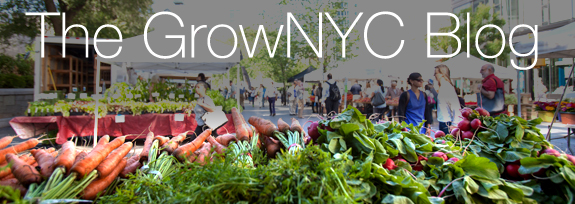
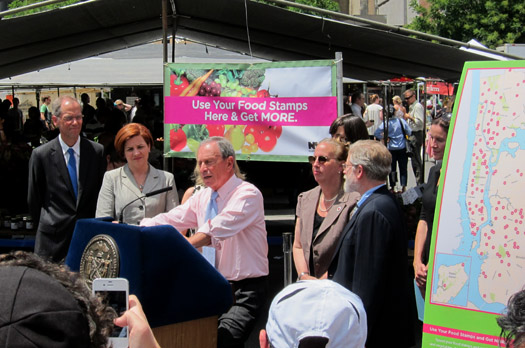 Mayor Bloomber (center) and (left to right) Health Commissioner Thomas A. Farley, City Council Speaker Christine Quinn, Congresswoman Carolyn Maloney, Council Member Gale Brewer, Greenmarket Assistant Director Cheryl Huber, Assembly Member Richard Gottfried, and NYC Food Policy Coordinator Kim Kessler, announcing the expansion of Health Bucks for the 2012 season on July 2 in the Union Square Greenmarket.
Mayor Bloomber (center) and (left to right) Health Commissioner Thomas A. Farley, City Council Speaker Christine Quinn, Congresswoman Carolyn Maloney, Council Member Gale Brewer, Greenmarket Assistant Director Cheryl Huber, Assembly Member Richard Gottfried, and NYC Food Policy Coordinator Kim Kessler, announcing the expansion of Health Bucks for the 2012 season on July 2 in the Union Square Greenmarket.

 Since 2010, Greenmarket has required its bakers to use at least 15% local flour in their breads and baked goods. Why? To make sure Greenmarket bakers are as much a part of local agriculture as Greenmarket farmers. The great news is that, since then, bakers have incorporated increasing amounts of locally-grown grains into their products. Greenmarket has helped by supporting grain farmers; creating connections to build processing infrastructure like mills, malt houses, and distilleries; and hosting tastings and other events to get customers excited about local grains. Greenmarket bakers now use an average of 50% local flour. With so many reasons to source local grains, this number will continue to grow! 15 Reasons to Eat Locally Grown Grain 1. Local grains taste better. Farmers grow a diverse variety of wheat and other grains, and these products travel a more direct path from the field to your pantry. Without the conventional additives, local grains have more interesting flavor profiles and taste fresher. 2. Local grains have more character. From their behavior in the bowl to their nutritional value, local grains are “alive”, making them more fun to work with and better for your body. 3. Local grains build healthy soils. Growing grains can prevent soil erosion and add organic matter to soils, building their fertility. In other words: Local grains help support the local vegetables we love! 4. Supporting local grains rebuilds regional food systems and the regional economy. In addition to the on-farm jobs they support, local grains require processing, storage, and distribution. This means more regional-scale infrastructure and jobs in these facilities. It also paves the way to create other regional food infrastructure for products like meat, pickled and processed goods, and more. 5. Nothing makes truly “artisan” bread like truly artisan grains. Bakers using regional grains are constantly innovating to celebrate the diverse flavors and characteristics of local grains, creating a richer array of products. 6. If eating emmer makes you sexy, eating einkorn makes you even sexier. Need we say more? 7. Local grains increase the diversity of products farmers can grow. This makes their businesses stronger and more resilient. It also makes local ecology more resilient by increasing biodiversity. 8. Greenmarket farmers grow these products really, really well. They do magic with tomatoes; imagine what they can do with spelt. 9. You shouldn’t have to go to Brighton Beach to get good buckwheat and rye bread. 10. Heritage corn makes better polenta, better tortillas, and better bourbon. 11. You can cook it, bake it, brew it AND distill it. 12. Local grains are traceable. No GMOs. No secrets. Just ask your farmer. 13. “Warthog” is fun to say. Our farmers love it for its beautiful agronomic traits. Our bakers love it for its rich flavor. We just like the way it sounds. 14. Because the “staff of life” should be local, too. 15. Bread is agriculture! And so is beer, whiskey, cake, and granola.
Since 2010, Greenmarket has required its bakers to use at least 15% local flour in their breads and baked goods. Why? To make sure Greenmarket bakers are as much a part of local agriculture as Greenmarket farmers. The great news is that, since then, bakers have incorporated increasing amounts of locally-grown grains into their products. Greenmarket has helped by supporting grain farmers; creating connections to build processing infrastructure like mills, malt houses, and distilleries; and hosting tastings and other events to get customers excited about local grains. Greenmarket bakers now use an average of 50% local flour. With so many reasons to source local grains, this number will continue to grow! 15 Reasons to Eat Locally Grown Grain 1. Local grains taste better. Farmers grow a diverse variety of wheat and other grains, and these products travel a more direct path from the field to your pantry. Without the conventional additives, local grains have more interesting flavor profiles and taste fresher. 2. Local grains have more character. From their behavior in the bowl to their nutritional value, local grains are “alive”, making them more fun to work with and better for your body. 3. Local grains build healthy soils. Growing grains can prevent soil erosion and add organic matter to soils, building their fertility. In other words: Local grains help support the local vegetables we love! 4. Supporting local grains rebuilds regional food systems and the regional economy. In addition to the on-farm jobs they support, local grains require processing, storage, and distribution. This means more regional-scale infrastructure and jobs in these facilities. It also paves the way to create other regional food infrastructure for products like meat, pickled and processed goods, and more. 5. Nothing makes truly “artisan” bread like truly artisan grains. Bakers using regional grains are constantly innovating to celebrate the diverse flavors and characteristics of local grains, creating a richer array of products. 6. If eating emmer makes you sexy, eating einkorn makes you even sexier. Need we say more? 7. Local grains increase the diversity of products farmers can grow. This makes their businesses stronger and more resilient. It also makes local ecology more resilient by increasing biodiversity. 8. Greenmarket farmers grow these products really, really well. They do magic with tomatoes; imagine what they can do with spelt. 9. You shouldn’t have to go to Brighton Beach to get good buckwheat and rye bread. 10. Heritage corn makes better polenta, better tortillas, and better bourbon. 11. You can cook it, bake it, brew it AND distill it. 12. Local grains are traceable. No GMOs. No secrets. Just ask your farmer. 13. “Warthog” is fun to say. Our farmers love it for its beautiful agronomic traits. Our bakers love it for its rich flavor. We just like the way it sounds. 14. Because the “staff of life” should be local, too. 15. Bread is agriculture! And so is beer, whiskey, cake, and granola.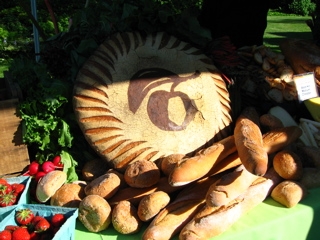 In 2010, after years of conversations with its bakers and farmers, Greenmarket implemented a rule requiring its bakers to source at least 15% of the flour they used from local farms and mills. As an organization which seeks to strengthen regional agriculture, Greenmarket wanted to ensure that all of its producers were in support of this mission. On the other hand, much of the infrastructure to grow and process grains in the Northeast had been lost throughout the decades. By implementing the 15% local flour rule, Greenmarket was asking its bakers to reflect the organization’s mission in their business models, while recognizing the inherent challenges that sourcing local flour could create. Now, two years later, Greenmarket is proud to announce that its bakers use an average of 50% local flour in their baked goods. New infrastructure has been added to the Northeast’s grain-shed, and this sector of the food system continues to grow. To highlight the success of this partnership between Greenmarket and its bakers, over the next few months Greenmarket will be sharing regular installments in our Bread is Agriculture series. Look out for interviews with bakers on the GrowNYC blog; Baked Good of the Week features on Facebook; and literature at the info booth at our markets, including 15 Reasons to Eat Local Grain.
In 2010, after years of conversations with its bakers and farmers, Greenmarket implemented a rule requiring its bakers to source at least 15% of the flour they used from local farms and mills. As an organization which seeks to strengthen regional agriculture, Greenmarket wanted to ensure that all of its producers were in support of this mission. On the other hand, much of the infrastructure to grow and process grains in the Northeast had been lost throughout the decades. By implementing the 15% local flour rule, Greenmarket was asking its bakers to reflect the organization’s mission in their business models, while recognizing the inherent challenges that sourcing local flour could create. Now, two years later, Greenmarket is proud to announce that its bakers use an average of 50% local flour in their baked goods. New infrastructure has been added to the Northeast’s grain-shed, and this sector of the food system continues to grow. To highlight the success of this partnership between Greenmarket and its bakers, over the next few months Greenmarket will be sharing regular installments in our Bread is Agriculture series. Look out for interviews with bakers on the GrowNYC blog; Baked Good of the Week features on Facebook; and literature at the info booth at our markets, including 15 Reasons to Eat Local Grain.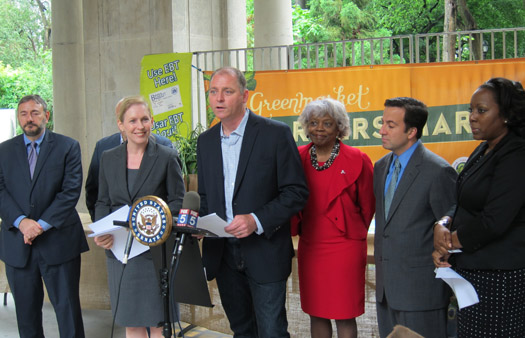 Marcel Van Ooyen, Executive Director of GrowNYC, welcomes Senator Kirsten Gillibrand and fellow anti-hunger advocates to Union Square.
Marcel Van Ooyen, Executive Director of GrowNYC, welcomes Senator Kirsten Gillibrand and fellow anti-hunger advocates to Union Square.


 The increasing prevalence of grains on New York area farms and in processing facilities throughout the region has manifested itself as a spectacular and delicious array of products and end uses in New York City, and around the Northeast. Conversations with businesses putting these locally-grown grains to work demonstrates a creativity and enthusiasm worthy of the hard work that has gone into their production. Bakeries are typically the first to come to mind when thinking about how consumers enjoy local grains and flours. The role that Greenmarket and its bakers have played in stimulating this facet of the food system confirms this important relationship. In 2010, interested in encouraging its bakers to be more mission supportive, Greenmarket implemented its Bakers Rules, which required bakers at market to use a minimum of 15% local flour in their breads and baked goods. Many staff and farmers in the Greenmarket community felt it only fair that bakers, who had long relied on commodity flours, incorporate practices into their businesses that would support local foods and farms. The 15% level was chosen in order to both create significant pressure on the Northeast grain-shed to grow, while recognizing that local flour was still somewhat of a novelty. Greenmarket bakers have become increasingly enthusiastic about the local flour rule since its implementation, and today some bakers go well beyond the 15% minimum requirement. As a result, the use of local flour by Greenmarket bakers has grown to an average of 50% used by each baker, and some bakers source the vast majority of their flour from farms throughout the region. At the same time, bakers outside of the Greenmarket system have shown their support of local agriculture through their sourcing practices, as well. In 2011, Peter Endriss, formerly of Hot Bread Kitchen, began baking and selling bread under his own label, Runner & Stone. From the beginning, Peter was interested in using local flours for Runner & Stone’s products. He had first gotten experience with these products at Hot Bread Kitchen; as a Greenmarket bakery, they source from the Northeast. But his involvement in Slow Food, and his background in natural resources management and environmental inspections, contribute to what he describes as a “natural marriage” between making great food and ensuring that it’s done in a low environmental impact way. For Endriss, the challenge comes in adapting these local flours and whole grains to achieve the products he envisions for Runner & Stone. His father is from Germany, and Peter spent some time early in his career baking in the Black Forest region. The influence of this period can be seen in the pretzel croissants and Schwabian pretzels that have made their way into his offerings at the Brooklyn Flea, where he sells his products each weekend. It is also apparent in his TKTKT ryes. Endriss also bakes products that have stayed with him from travels to Paris, like the canneles he says he just started making because “I wanted to eat it”. All of the whole grain and all purpose flours Endriss uses are locally sourced, and in the fall he will be opening a retail bakery and full-service Runner & Stone restaurant in Gowanus, which will feature local and seasonal products throughout the menu. The crafting of locally-grown grains into delicious concoctions and products doesn’t stop at bread. Farm-forward restaurants are increasingly featuring local grains on their menus, from pastas to risottos to more out-of-the-box dishes that often depart from the traditional fixation on protein-obsessed cuisine. Chef Mike Anthony, who has been the chef at Gramercy Tavern for the past six years, describes the infusion of grains throughout his menu, both as a professional chef and as a parent. Anthony’s commitment to exploring products like freekeh or barley reflects his growing awareness that grains form a foundation of the way we eat. He explains that, at home, he can augment a basket of local produce with locally-grown grains to create meals that are nutritious, but also filling. Given that they are such a fundamental component of our diets, Anthony has likewise created dishes for his restaurant that pay homage to this food group, while re-defining what luxury food means to New York eaters. Rather than adopting a European palette focused on imported ingredients, Anthony defines luxury as a connection to source, and an ability to explore luscious textures and amazing aromas through ingredients that have a back-story. He describes a dish where barley is cooked until soft with vegetable stock, then folded into reduced carrot juice and a rainbow of glazed carrots of different varieties. Over the top he showers grilled carrots, then shaves raw carrot over the top. While lacking in the traditional richness associated with luxury foods – butter, cream, cheese – this dish explores texture and color through simple, incredibly fresh ingredients. In addition to an ever-evolving palette of dishes such as this one, Gramercy tavern uses spelt flour in their hamburger buns. In 2012, Anthony plans to introduce a spelt pasta, as well – which, he explains, will have a soba-like quality. He plans to pair it with grilled ramps. Also milling around in his imagination: How to bring Einkorn, an ancient grain with an emerging presence in the Northeast grainshed, into his kitchen. As farmers broaden the array of grains they produce, and processing capacity grows and diversifies, the number of end-uses for local grains has also expanded. Not least among the emerging users of local grains are the region’s brewers and distillers. Just last year, Greenmarket introduced its first beer vendor at market – Tundra Brewing. From this promising start-up all the way up to what is perhaps the city’s best-known beer-maker – Brooklyn Brewery – we are seeing more and more local grains in our pint glasses. In 2011, Brooklyn Brewery introduced the High Line Elevated Wheat, a seasonal brew available for sale exclusively on the High Line. While Brooklyn Brewery has used local honey for some time, many of the other ingredients necessary for brewing beer have been largely unavailable at the local level, until recently. For the Elevated Wheat, Brooklyn Brewery sourced red winter wheat from North Country Farms. The wheat was selected because it grows well in New York State, and also because of its nice, smoky flavor. While the Elevated Wheat was brewed specially for the 2011 season, Brooklyn Brewery has ambitions for expanding its repertoire of beers using local grains sometime in the future. One hope is to grow barley specifically for the brewery on Long Island, malt it locally in Brooklyn, and combine it with locally-grown hops to create an entirely local Brooklyn brew. The number of new distilleries cropping up in and around New York City is perhaps the most impressive example of the development of regional grain-focused businesses. Take Tuthilltown Spirits, for example. A pioneering farm distillery since the early 2000s, as of 2011 Tuthilltown sourced 90% of its grains from within NY State, the majority from within 10 miles of the distillery. These grains include a variety of corn called Whapsie Valley, as well as rye varietals that were identified with the help of a seed saver in New England. As a farm distillery, Tuthilltown must be financially responsible for its crops, meaning that it leases land from partner farms and hires the farmer to grow the grains for the distillery; this arrangement provides an incentive for a farmer to grow obscure grains that may otherwise be absent from the Northeast agricultural landscape. Tuthilltown Spirits spent some time in 2011 experimenting with some less conventional grains in its distillery, including spelt, oats, and triticale. While they haven’t released any of these experimental batches, they plan to continue trying different grains and eventually releasing small batches of these spirits, most likely within the next year and a half. They’re also working with a New York producer of wild rice, and thinking more and more about soju, which can be made from both locally-grown sweet potatoes or barley. Tuthilltown is not the only distiller using local grains to bring great spirits to consumers in the region. Finger Lakes Distilling, The New York Distilling Company, and Breuckelen Distilling are among other businesses with a commitment to supporting the local grain-shed. And, as growth continues to occur all along the Northeast grains value chain, the diversity of appearances of local grains in city restaurants, bakeries, markets, and on store shelves will likely grow, as well.
The increasing prevalence of grains on New York area farms and in processing facilities throughout the region has manifested itself as a spectacular and delicious array of products and end uses in New York City, and around the Northeast. Conversations with businesses putting these locally-grown grains to work demonstrates a creativity and enthusiasm worthy of the hard work that has gone into their production. Bakeries are typically the first to come to mind when thinking about how consumers enjoy local grains and flours. The role that Greenmarket and its bakers have played in stimulating this facet of the food system confirms this important relationship. In 2010, interested in encouraging its bakers to be more mission supportive, Greenmarket implemented its Bakers Rules, which required bakers at market to use a minimum of 15% local flour in their breads and baked goods. Many staff and farmers in the Greenmarket community felt it only fair that bakers, who had long relied on commodity flours, incorporate practices into their businesses that would support local foods and farms. The 15% level was chosen in order to both create significant pressure on the Northeast grain-shed to grow, while recognizing that local flour was still somewhat of a novelty. Greenmarket bakers have become increasingly enthusiastic about the local flour rule since its implementation, and today some bakers go well beyond the 15% minimum requirement. As a result, the use of local flour by Greenmarket bakers has grown to an average of 50% used by each baker, and some bakers source the vast majority of their flour from farms throughout the region. At the same time, bakers outside of the Greenmarket system have shown their support of local agriculture through their sourcing practices, as well. In 2011, Peter Endriss, formerly of Hot Bread Kitchen, began baking and selling bread under his own label, Runner & Stone. From the beginning, Peter was interested in using local flours for Runner & Stone’s products. He had first gotten experience with these products at Hot Bread Kitchen; as a Greenmarket bakery, they source from the Northeast. But his involvement in Slow Food, and his background in natural resources management and environmental inspections, contribute to what he describes as a “natural marriage” between making great food and ensuring that it’s done in a low environmental impact way. For Endriss, the challenge comes in adapting these local flours and whole grains to achieve the products he envisions for Runner & Stone. His father is from Germany, and Peter spent some time early in his career baking in the Black Forest region. The influence of this period can be seen in the pretzel croissants and Schwabian pretzels that have made their way into his offerings at the Brooklyn Flea, where he sells his products each weekend. It is also apparent in his TKTKT ryes. Endriss also bakes products that have stayed with him from travels to Paris, like the canneles he says he just started making because “I wanted to eat it”. All of the whole grain and all purpose flours Endriss uses are locally sourced, and in the fall he will be opening a retail bakery and full-service Runner & Stone restaurant in Gowanus, which will feature local and seasonal products throughout the menu. The crafting of locally-grown grains into delicious concoctions and products doesn’t stop at bread. Farm-forward restaurants are increasingly featuring local grains on their menus, from pastas to risottos to more out-of-the-box dishes that often depart from the traditional fixation on protein-obsessed cuisine. Chef Mike Anthony, who has been the chef at Gramercy Tavern for the past six years, describes the infusion of grains throughout his menu, both as a professional chef and as a parent. Anthony’s commitment to exploring products like freekeh or barley reflects his growing awareness that grains form a foundation of the way we eat. He explains that, at home, he can augment a basket of local produce with locally-grown grains to create meals that are nutritious, but also filling. Given that they are such a fundamental component of our diets, Anthony has likewise created dishes for his restaurant that pay homage to this food group, while re-defining what luxury food means to New York eaters. Rather than adopting a European palette focused on imported ingredients, Anthony defines luxury as a connection to source, and an ability to explore luscious textures and amazing aromas through ingredients that have a back-story. He describes a dish where barley is cooked until soft with vegetable stock, then folded into reduced carrot juice and a rainbow of glazed carrots of different varieties. Over the top he showers grilled carrots, then shaves raw carrot over the top. While lacking in the traditional richness associated with luxury foods – butter, cream, cheese – this dish explores texture and color through simple, incredibly fresh ingredients. In addition to an ever-evolving palette of dishes such as this one, Gramercy tavern uses spelt flour in their hamburger buns. In 2012, Anthony plans to introduce a spelt pasta, as well – which, he explains, will have a soba-like quality. He plans to pair it with grilled ramps. Also milling around in his imagination: How to bring Einkorn, an ancient grain with an emerging presence in the Northeast grainshed, into his kitchen. As farmers broaden the array of grains they produce, and processing capacity grows and diversifies, the number of end-uses for local grains has also expanded. Not least among the emerging users of local grains are the region’s brewers and distillers. Just last year, Greenmarket introduced its first beer vendor at market – Tundra Brewing. From this promising start-up all the way up to what is perhaps the city’s best-known beer-maker – Brooklyn Brewery – we are seeing more and more local grains in our pint glasses. In 2011, Brooklyn Brewery introduced the High Line Elevated Wheat, a seasonal brew available for sale exclusively on the High Line. While Brooklyn Brewery has used local honey for some time, many of the other ingredients necessary for brewing beer have been largely unavailable at the local level, until recently. For the Elevated Wheat, Brooklyn Brewery sourced red winter wheat from North Country Farms. The wheat was selected because it grows well in New York State, and also because of its nice, smoky flavor. While the Elevated Wheat was brewed specially for the 2011 season, Brooklyn Brewery has ambitions for expanding its repertoire of beers using local grains sometime in the future. One hope is to grow barley specifically for the brewery on Long Island, malt it locally in Brooklyn, and combine it with locally-grown hops to create an entirely local Brooklyn brew. The number of new distilleries cropping up in and around New York City is perhaps the most impressive example of the development of regional grain-focused businesses. Take Tuthilltown Spirits, for example. A pioneering farm distillery since the early 2000s, as of 2011 Tuthilltown sourced 90% of its grains from within NY State, the majority from within 10 miles of the distillery. These grains include a variety of corn called Whapsie Valley, as well as rye varietals that were identified with the help of a seed saver in New England. As a farm distillery, Tuthilltown must be financially responsible for its crops, meaning that it leases land from partner farms and hires the farmer to grow the grains for the distillery; this arrangement provides an incentive for a farmer to grow obscure grains that may otherwise be absent from the Northeast agricultural landscape. Tuthilltown Spirits spent some time in 2011 experimenting with some less conventional grains in its distillery, including spelt, oats, and triticale. While they haven’t released any of these experimental batches, they plan to continue trying different grains and eventually releasing small batches of these spirits, most likely within the next year and a half. They’re also working with a New York producer of wild rice, and thinking more and more about soju, which can be made from both locally-grown sweet potatoes or barley. Tuthilltown is not the only distiller using local grains to bring great spirits to consumers in the region. Finger Lakes Distilling, The New York Distilling Company, and Breuckelen Distilling are among other businesses with a commitment to supporting the local grain-shed. And, as growth continues to occur all along the Northeast grains value chain, the diversity of appearances of local grains in city restaurants, bakeries, markets, and on store shelves will likely grow, as well.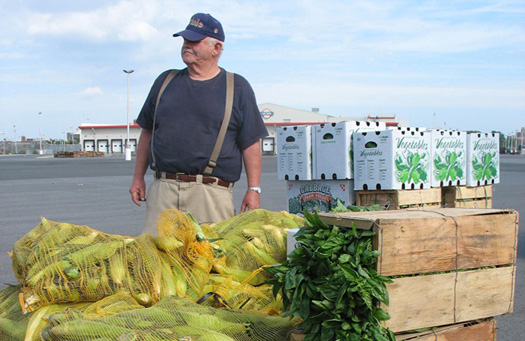





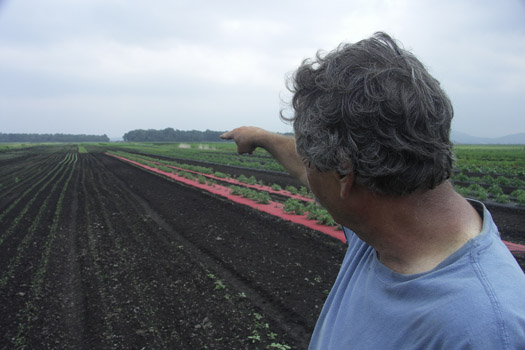 GrowNYC is pleased to announce that $100,862 in donated funds has been distributed to regional farmers who were hit hardest by last summer’s storms. When Tropical Storms Irene and Lee severely impacted 80% of Greenmarket producers last September, our community rallied together to help overcome the damage that was wrought. Greenmarket customers held benefit potlucks, concerts and after-work parties; a group of food writers organized the successful Dine Out Irene in which over one hundred restaurants donated a percentage of their sales from a Sunday in late September; instead of a wedding registry, a woman asked her friends and family to make donations to farmers, and close to $5,000 was raised by customers who opened their pocketbooks at Greenmarkets around the city to make donations directly to the GrowNYC Hurricane Relief Fund. "The generosity that Greenmarket shoppers showed during this time of need is proof of the valuable relationships that develop between farmers and customers at market,” says GrowNYC Executive Director Marcel Van Ooyen. “While these storms had less of an impact on the city, New Yorkers felt the gravity of the situation through their rural neighbors and friends who sell at Greenmarket." One hundred percent of all funds raised by GrowNYC for Hurricane Relief were given directly to farmers. The funds were distributed based on need in two waves of grants—one in December and one in March. Recipients report that these resources have helped them overcome last September’s losses, and get a good start on the new season. In addition to repairing flood-damaged machinery and barns, farmers have used their grants to purchase seeds, laying hens, truck parts, pay fuel bills, and much more. "I could have pulled any number of other bills from the stack of need last fall," said Richard Giles of Lucky Dog Farm, explaining how he spent his relief check from GrowNYC. The bills paid by the Hurricane Relief Fund covered "Vegetable twist ties, a power bill, a seed bill, one for truck tires, another for truck parts, and one for potting soil. I am so thankful to Greenmarket for coordinating this wonderful support." With this assistance, Lucky Dog was able to continue selling at the Fort Greene and Union Square Greenmarkets through the winter, and is now launching into the 2012 growing season. “Greenmarket is our survival plan,” said Giles.
GrowNYC is pleased to announce that $100,862 in donated funds has been distributed to regional farmers who were hit hardest by last summer’s storms. When Tropical Storms Irene and Lee severely impacted 80% of Greenmarket producers last September, our community rallied together to help overcome the damage that was wrought. Greenmarket customers held benefit potlucks, concerts and after-work parties; a group of food writers organized the successful Dine Out Irene in which over one hundred restaurants donated a percentage of their sales from a Sunday in late September; instead of a wedding registry, a woman asked her friends and family to make donations to farmers, and close to $5,000 was raised by customers who opened their pocketbooks at Greenmarkets around the city to make donations directly to the GrowNYC Hurricane Relief Fund. "The generosity that Greenmarket shoppers showed during this time of need is proof of the valuable relationships that develop between farmers and customers at market,” says GrowNYC Executive Director Marcel Van Ooyen. “While these storms had less of an impact on the city, New Yorkers felt the gravity of the situation through their rural neighbors and friends who sell at Greenmarket." One hundred percent of all funds raised by GrowNYC for Hurricane Relief were given directly to farmers. The funds were distributed based on need in two waves of grants—one in December and one in March. Recipients report that these resources have helped them overcome last September’s losses, and get a good start on the new season. In addition to repairing flood-damaged machinery and barns, farmers have used their grants to purchase seeds, laying hens, truck parts, pay fuel bills, and much more. "I could have pulled any number of other bills from the stack of need last fall," said Richard Giles of Lucky Dog Farm, explaining how he spent his relief check from GrowNYC. The bills paid by the Hurricane Relief Fund covered "Vegetable twist ties, a power bill, a seed bill, one for truck tires, another for truck parts, and one for potting soil. I am so thankful to Greenmarket for coordinating this wonderful support." With this assistance, Lucky Dog was able to continue selling at the Fort Greene and Union Square Greenmarkets through the winter, and is now launching into the 2012 growing season. “Greenmarket is our survival plan,” said Giles.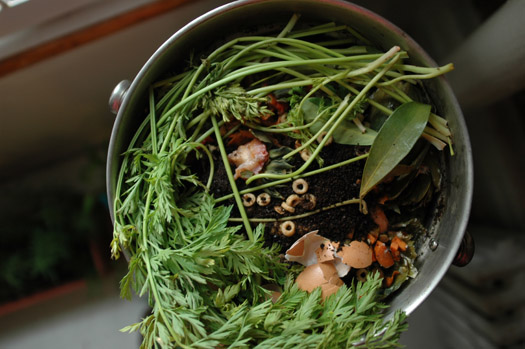
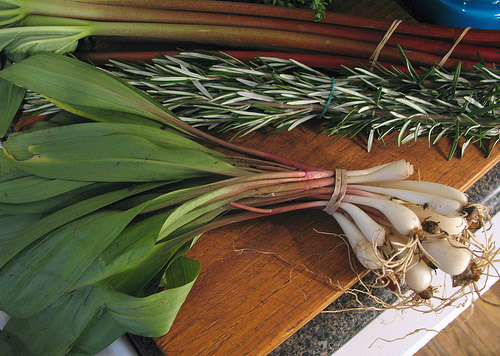 What do airports, interstate highways, skateboard parks, and Greenmarket all have in common?
What do airports, interstate highways, skateboard parks, and Greenmarket all have in common?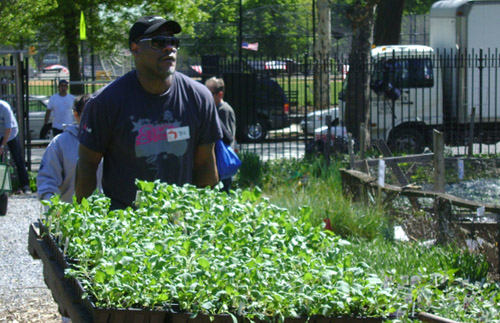 JOE BUCK As an Open Space Greening volunteer with GrowNYC, Joe has led teams of volunteers at Greening's biggest event of the year, the
JOE BUCK As an Open Space Greening volunteer with GrowNYC, Joe has led teams of volunteers at Greening's biggest event of the year, the 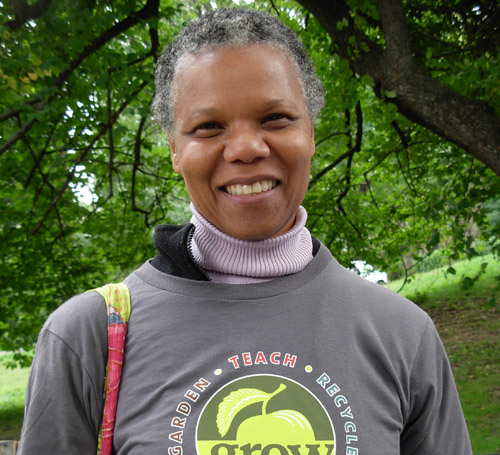 NANCY RAPHAEL As a recycling volunteer with GrowNYC, Nancy has helped teach New Yorkers about composting and contributed to successful recycling at
NANCY RAPHAEL As a recycling volunteer with GrowNYC, Nancy has helped teach New Yorkers about composting and contributed to successful recycling at 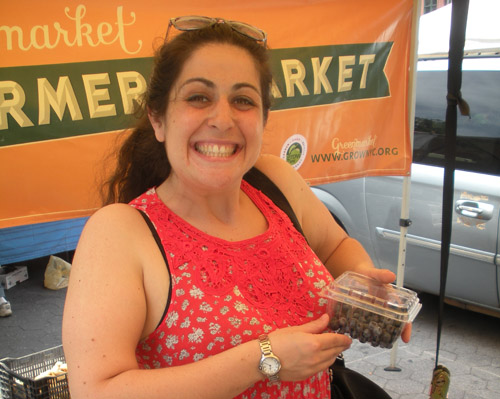 ERIN EASTERN As a Greenmarket volunteer with GrowNYC, Erin staffs
ERIN EASTERN As a Greenmarket volunteer with GrowNYC, Erin staffs